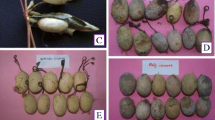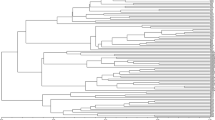Abstract
The silkworm is an ideal lepidopteran model for the study of genetics and genetic diversity. In this study, inter-simple sequence repeats (ISSR) and Simple Sequence Repeats (SSRs) were used to investigate genetic relationships among 32 mulberry silkworm genotypes which included bivoltine and multivoltine silkworm breeds. Genomic DNA was isolated from the silkmoth samples and six polymorphic ISSRs were utilized to screen the genotypes. A total of 641 scorable alleles were identified among 32 silkworm genotypes utilizing six polymorphic ISSR markers and size ranged from ~ 100 to ~ 1400 bp. The percent polymorphism for six ISSR primers ranged from 46.15 to 63.63%. A total of six monomorphic alleles were observed, accounting for 8.57%. Similarly, three thermotolerant SSR markers were screened which revealed a total of 108 alleles with a polymorphism of 69.44%. The molecular mass of the alleles ranged from ~ 190 bp to ~ 250 bp. The chi square based similarity index represents a clear genetic similarity of the silkworm breeds BMV2 and BM22 (0.23) and the maximum genetic distance for breeds TMS knob and CSR27SL (1.32). Cluster dendrogram utilizing distance matrix classified the genotypes into two clusters with five sub clusters representing highest polymorphism with 21 genotypes. Thus, ISSRs and SSRs polymorphic markers are informative for estimating the extent of genetic diversity as well as to determine the pattern of genetic relationships between different silkworm genotypes and provide unique molecular identity based on the identified monomorphic bands. ISSR and SSR marker-based barcodes could be an effective tool for the selection of parentage in silkworm breeding programs.
Graphical Abstract





Similar content being viewed by others
References
Alam K, Raviraj VS, Chowdhury T, Bhuimali A, Ghosh P, Saha S. Application of biotechnology in sericulture: progress, scope and prospect. Nucleus. 2022;65(1):129–221.
Awasthi AK, Nagaraja GM, Naik GV, Sriramana Thangavelu K, Nagaraju J. Genetic diversity and relationships in mulberry (genus Morus) as revealed by RAPD and ISSR marker assays. BMC Genet. 2004;5:1.
Bakappa S, Talebi E, Subramanya G. Role of molecular markers (RAPD & ISSR) in silkworm conservation. Int J Adv Biotechnol Res. 2011;1(1):01–7.
Bijaya T, Ramachandra NB. Genomic introgression in laboratory evolved hybrid races, Cytorace 1 and Fissioncytorace-1 of Nasuta-Albomicans Complex (NAC) of Drosophila as revealed by RAPD and ISSR markers. Ital J Zool. 2012;79(4):520–9.
Chandrakanth N, Moorthy SM, Ponnuvel KM, Sivaprasad V. Identification of microsatellite markers linked to thermotolerance in silkworm by bulk segregant analysis and in silico mapping. Genetika. 2015;47(3):1063–115.
Chatterjee SN, Pradeep AR. Molecular markers (RAPD) associated with growth, yield and origin of the silkworm, Bombyx mori in India. Rus J Genet. 2003;39:1612–712.
Chatterjee SN, Mohandas TP. Identification of ISSR markers associated with productivity traits in silkworm Bombyx mori L. Genome. 2003;46(3):438–9.
Chowdhury MA, Vandenberg B, Warkentin T. Cultivar identification and genetic relationship among selected breeding lines and cultivars in chickpea (Cicer arietinum L.). Euphytica. 2002;127:317.
Dos Santos LF, de Oliveira EJ, dos Santos SA, de Carvalho FM, Costa JL, Padua JG. ISSR markers as a tool for the assessment of genetic diversity in Passiflora. Biochem Genet. 2011;49(7–8):540–54.
Estoup A, Solignac M, Harry M, Cornuet JM. Characterization of (GT)n and (CT)n microsatellites in two insect species: Apis mellifera and Bombus terrestris. Nuc Acids Res. 1993;21:1427–8.
Gaviria DA, Aguilar E, Serrano HJ, Alegria AH. DNA fingerprinting using AFLP markers to search for markers associated with yield attributes in the silkworm Bombyx mori. J Insect Sci. 2006;6:1–10.
Goldsmith MR, Shimada T, Abe H. The genetics and genomics of the silkworm Bombyx mori. Ann Rev Entomol. 2005;50:71–100.
Goulao L, Oliveira CM. Molecular characterisation of cultivars of apple (Malus × domestica Borkh.) using microsatellite (SSR and ISSR) markers. Euphytica. 2001;122:81–9.
Jankowski C, Naser F, Nag DK. Meiotic instability of CAG repeat tracts occurs by double-strand break repair in yeast. Proc Natl Acad Sci USA. 2000;97:2134–9.
Kar PK, Vijayan K, Nair CV, Mohandas TP, Saratchandra B, Thangavelu K. Genetic variability and genetic structure of wild and semi-domestic populations of tasar silkworm (Antheraea mylitta) ecorace Daba as revealed through ISSR markers. Genetica. 2005;125:173–210.
Kimpton CP, Gill P, Walton A, Urquhart A, Millican ES, Adams M. Automated DNA profiling employing multiplex amplification of short tandem repeat loci. PCR Methods Appl. 1993;3:13–22.
Kostia S, Ruohonen-Lehto M, Vainola R, Varvio SL. Phylogenetic information in inter-SINE and inter-SSR fingerprints of the Artiodactyla and evolution of the BovtA SINE. Heredity. 2000;84:37–45.
Mason AS. SSR genotyping. In: Batley J, editor. Plant genotyping. New York: Springer; 2015. p. 77–89.
Mita K, Morimyo M, Okano K, Koike Y, Nohata J, Kawasaki H, Kadono-Okuda K, Yamamoto K, Suzuki MG, Shimada T, Goldsmith MR, Maeda S. The construction of an EST database for Bombyx mori and its application. Proc Natl Acad Sci. 2003;100(24):14121–5.
Moorthy SM, Chandrakanth N, Sivaprasad V. Molecular marker based selection of parents for breeding thermotolerant silkworm breeds/hybrids suitable for tropics of india. Indian J Seric. 2017;56(1–2):10–6.
Nagaraja GM, Nagaraju J. Genome fingerprinting of the silkworm, Bombyx mori using random arbitrary primers. Electrophoresis. 1995;16:1633–8.
Nagaraju J, Goldsmith MR. Silkworm genomics:progress and prospects. Curr Sci. 2002;83:415–25.
Pradeep AR, Chatterjee SN, Nair CV. Genetic differentiation induced by selection in an inbred population of the silkworm Bombyx mori, revealed by RAPD and ISSR marker systems. J Appl Genet. 2005;46:291–307.
Srivastava PP, Kar PK, Awasthi AK, Urs SR. Identification and association of ISSR markers for thermal stress in polyvoltine silkworm Bombyx mori. Russ J Genet. 2007;43:858–64.
Reddy KD, Nagaraju J, Abraham EG. Genetic characterization of the silkworm Bombyx mori by simple sequence repeat (SSR)–anchored PCR. Heredity. 1999;83:681–7.
Reineke A, Karlovsky P, Zebitz CPW. Preparation and purification of DNA from insects for AFLP analysis. Insect Mol Biol. 1998;7:95–8.
Renuka G, Shamitha G. Genetic variation in ecoraces of tropical tasar silkworm, Antheraea mylitta using SSR markers. J Genet. 2016;95:777–808.
Sandes SS, Zucchi MI, Pinheiro JB, Bajay MM, Batista CE, Brito FA, et al. Molecular characterization of patchouli (Pogostemon spp) germplasm. Genet Mol Res. 2016;15(1):2–12.
Schlotterer C. Evolutionary dynamics of microsatellite DNA. Chromosoma. 2000;109:365–71.
Soares AN, Vitoria MF, Nascimento AL, Ledo AS, Rabbani AR, Silva AV. Genetic diversity in natural populations of mangaba in Sergipe, the largest producer State in Brazil. Genet Mol Res. 2016;15(3):1–12.
Strand M, Prolla TA, Liskay RM, Petes TD. Destabilization of tracts of simple repetitive DNA in yeast by mutations affecting DNA mismatch pair. Nature. 1993;365:274–6.
Tan YD, Wan C, Zhu Y, Lu C, Xiang Z, Deng HW. An amplified fragment length polymorphism map of the silkworm. Genetics. 2001;157(3):1277–84.
Trochez-Solarte JD, Ruiz-Erazo X, Almanza-Pinzon M, Zambrano-Gonzalez G. Role of microsatellites in genetic analysis of Bombyx mori silkworm: a review. F1000Res. 2019;13(8):1424.
Vieira MLC, Santini L, Diniz AL, Munhoz CF. Microsatellite markers: what they mean and why they are so useful. Genet Mol Biol. 2016;39(3):312–28.
Vijayan K, Anuradha HJ, Nair CV, Pradeep AR, Awasthi AK, Saratchandra B, Rahman SA, Singh KC, Chakraborti R, Urs SR. Genetic diversity and differentiation among populations of the Indian eri silkworm, Samia cynthia ricini, revealed by ISSR markers. J Insect Sci. 2006;6:1–11.
Wang ZY, Tanksley SD. Restriction fragment length polymorphism in Oryza sativa L. Genome. 1989;32:1113–8.
Williams JGK, Kubelik AR, Livak KJ, Rafalski JA, Tingey SV. DNA polymorphisms amplified by arbitrary primers are useful as genetic markers. Nucleic Acids Res. 1990;18:6531–5.
Wolfe AD, Liston A. Contributions of PCR-based methods to plant systematics and evolutionary biology. In: Soltis DE, Soltis PS, Doyle JJ, editors. Molecular systematics of plants II: DNA sequencing. New York: Kluwer; 1998. p. 43–86.
Yamamoto K, Narukawa J, Kadono-Okuda K, Nohata J, Sasanuma M, Suetsugu Y, Banno Y, Fujii H, Goldsmith MR, Mita K. Construction of a single nucleotide polymorphism linkage map for the silkworm, Bombyx mori, based on bacterial artificial chromosome end sequences. Genetics. 2006;173(1):151–61.
Zietkiewicz E, Rafalski A, Labuda D. Genome fingerprinting by simple sequence repeat (SSR)-anchored polymerase chain reaction amplification. Genomics. 1994;20:176–83.
Acknowledgements
The authors thank the Director, CSRTI, Mysuru for the support in carrying out the work.
Funding
The work was funded by Central Silk Board, Ministry of Textiles and Department of Biotechnology, New Delhi, Government of India.
Author information
Authors and Affiliations
Contributions
The study was conceptualized and designed by KL, SL, MSM, SV. Material preparation was carried out by KL, SL and KBC. Data collection and analysis was performed by KL, SL, PI and HG. The first draft of the manuscript was written by KL and all authors commented on previous versions of the manuscript. All authors read and approved the final manuscript.
Corresponding author
Ethics declarations
Conflict of interest
The authors declare that there is no competing / conflict of interest.
Consent for publication
The authors hereby agree for publication.
Additional information
Publisher's Note
Springer Nature remains neutral with regard to jurisdictional claims in published maps and institutional affiliations.
Corresponding Editor: Bani Gajra, Reviewers: Gaurab Gangopadhyay, K Nagraja, Manoj M. Lekhak.
Supplementary Information
Below is the link to the electronic supplementary material.


Rights and permissions
Springer Nature or its licensor (e.g. a society or other partner) holds exclusive rights to this article under a publishing agreement with the author(s) or other rightsholder(s); author self-archiving of the accepted manuscript version of this article is solely governed by the terms of such publishing agreement and applicable law.
About this article
Cite this article
Lingaiah, K., Lokanath, S., Iyengar, P. et al. Analysis of genetic variability among bivoltine and multivoltine silkworm genotypes using inter simple sequence repeat and simple sequence repeat markers. Nucleus (2023). https://doi.org/10.1007/s13237-023-00436-4
Received:
Accepted:
Published:
DOI: https://doi.org/10.1007/s13237-023-00436-4




